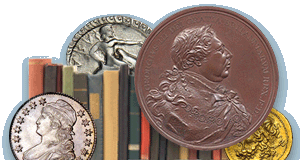
PREV ARTICLE
NEXT ARTICLE
FULL ISSUE
PREV FULL ISSUE
LOOSE CHANGE: OCTOBER 12, 2025Here are some additional items in the media this week that may be of interest. -Editor A Greyheet article by Michael Garofalo examines Robert Scot's Draped Bust Half Cents. Here's an excerpt - see the complete article online. -Editor After the American Revolutionary War had ended, the new fledgling government didn't have an army, a navy, or even its own money to spend. The Coinage Act of 1792 established that the United States should create its own minting facility and to create America's own coinage. When the Philadelphia Mint opened for business in 1793, it first struck copper coins—Half Cents and Large Cents. Coinage in America at that time was a hodgepodge of foreign coins, each with its own unique value, so buying food priced in British Pounds with Dutch Guilders became a complicated transaction. Standardized American coins would make commerce much easier to conduct. In 1793, the Mint struck only 35,534 Half Cents, all of which bore the Liberty Cap and Pole obverse with a Wreath reverse. All of these coins were designed by the first Chief Engraver of the United States Mint, Robert Scot. He was a Scottish-American engraver who was born in 1745 in Cannongate, Scotland. He moved to Fredericksburg, Virgina in 1775 and he changed the spelling of his last name from 'Scott' to 'Scot,' to make himself seem more American. One of his earliest jobs in America was engraving plates for Virginia's colonial banknotes. Ironically, the banknotes he engraved were adorned with the Coat of Arms of Great Britain. But a year later, as the Colonies declared their independence, the British Coat of Arms was replaced with a new design representing the Commonwealth of Virginia.
To read the complete article, see:
Noonan's recently sold a group of medals belonging to a woman who perished on the Lusitania. -Editor Anna Endresen died when the SS Lusitania was torpedoed and sunk off Old Head, Kinsale, on May 7 1915. Originally from Norway, Endresen was a professional in the British Mercantile Marine. She served as matron in the Steward's Department on the Lusitania's final voyage. Anything associated with the Lusitania is of interest to collectors, and this group of medals is especially rare because they were awarded to a woman. On July 16, Endresen's British war medal 1914-20, Mercantile Marine war medal 1914-18, and memorial plaque: ‘She Died For Freedom and Honour' sold for £11,000 (€12,644) at Noonan's in London. While we're all aware of the famous Karl Goetz medal on the sinking of the ship, the article notes that "British propagandists leapt on the opportunity to use the medal in a counter-propaganda campaign. Thousands of copies of the medal were produced by the British government and sold in Selfridges for one shilling each, with proceeds going to the British war effort." I wasn't familiar with the British copies - how are they differentiated from the Goetz originals? -Editor
To read the complete article, see:
Dick Hanscom passed along this Daily Mail article about "ancient artifacts found on sale for $22 at Canadian thrift store." Thanks. -Editor A set of ancient artifacts were discovered on sale for just $22 at a Canadian thrift store. The set of precious rings and medallions were spotted by a shopper at Thrifty Boutique, a charity thrift store in Chilliwack, around 60 miles from Vancouver. The customer had a background in archeology and alerted the store's volunteers who brought in experts from Simon Fraser University. Eleven rings and two medallions were handed over which are believed to date back to medieval or Roman times. The exact age and value of the artifacts is still under study, but it is suspected they are worth well above the $30 CAD OR $21.50 USD they were listed for. 'This is an incredibly exciting donation and an amazing opportunity for students here at SFU,' Sabrina Higgins, an associate professor in global humanities and archeology, said. The jewelry has been placed in the care of SFU's Museum of Archeology and Ethnology and is set to become apart of the student's curriculum.
To read the complete article, see:
Wayne Homren, Editor The Numismatic Bibliomania Society is a non-profit organization promoting numismatic literature. See our web site at coinbooks.org. To submit items for publication in The E-Sylum, write to the Editor at this address: whomren@gmail.com To subscribe go to: Subscribe All Rights Reserved. NBS Home Page Contact the NBS webmaster 
|


